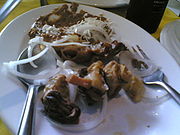
Tripas
Encyclopedia

Mexican cuisine
Mexican cuisine, a style of food that originates in Mexico, is known for its varied flavors, colourful decoration and variety of spices and ingredients, most of which are native to the country. The cuisine of Mexico has evolved through thousands of years of blending indigenous cultures, with later...
are the small intestines of farm animals that have been cleaned, boiled and grilled. Tripas are used as filling for taco
Taco
A taco is a traditional Mexican dish composed of a corn or wheat tortilla folded or rolled around a filling. A taco can be made with a variety of fillings, including beef, chicken, seafood, vegetables and cheese, allowing for great versatility and variety...
s, then dressed with condiments such as cilantro, chopped onions, and chile sauce
Salsa (sauce)
Salsa may refer to any type of sauce. In American English, it usually refers to the spicy, often tomato based, hot sauces typical of Mexican and Central American cuisine, particularly those used as dips. In British English, the word typically refers to salsa cruda, which is common in Mexican ,...
. They are also served with Pico De Gallo
Pico de gallo
In Mexican cuisine, pico de gallo , also called salsa fresca, is a fresh, uncooked condiment made from chopped tomato, white onion, and chilis...
and Guacamole
Guacamole
Guacamole , is an avocado-based dip that originated in Mexico. It is traditionally made by mashing ripe avocados with a molcajete with sea salt. Some recipes call for limited tomato, spicy Asian spices such as white onion, lime juice, and/or additional seasonings.-History:Guacamole was made by...
.
Preparation
Tripas as prepared Mexican style require care by the cook to avoid becoming rubbery. They are traditionally cooked in a "Disco" (dee-sko) which is constructed of two tilling discs (commonly used in the farming industry) welded to an iron pole in the center of the discs to form a wok like bowl on top of the pole with another disc about 8" - 10" below it. The tripas are placed in the top disc and filled with water while the lower disc is filled with wood or charcoal, thus creating the heat to cook the tripas. The tripas are boiled for several hours until tender, adding water as needed. Once they are tender the cook will allow the water to boil off and then finish the preparation by continuing to let them cook in their own fat.Tripas are prepared to three levels. Soft preparation is attained shortly after the water boils off while the tripas are still tender with a velvet like texture. Properly prepared, they should not be rubbery but should have some firmness to them. Medium Crispy is reached by allowing the tripas to continue to cook in their own fat long enough for the exterior to crisp and harden. The center of the tripas are usually still soft and velvety. Finally Extra Crispy preparation is reached by allowing the tripas to cook long enough to get crispy all the way through. Sometimes lard is added to the disco to reach this level of crispness but the true "Cocineros" (Mexican chefs) contend that it is best done using their own fat.
Tripas de leche are similar in appearance to regular tripas, but are made from the internals of a cow's udder
Udder
An udder is an organ formed of the mammary glands of female quadruped mammals, especially ruminants such as cattle, goats, sheep and deer. The udder is a single mass hanging beneath the animal, consisting of pairs of mammary glands...
. Tripas de leche are typically tenderized by marinating, then grilled.
Portuguese tripas
Tripas in Portuguese cuisinePortuguese cuisine
Portuguese cuisine is characterised by rich, filling and full-flavored dishes and is closely related to Mediterranean cuisine. The influence of Portugal's former colonial possessions is also notable, especially in the wide variety of spices used. These spices include piri piri and black pepper, as...
, is beef stomach, and in the form of Tripas à moda do Porto (tripe with white beans) is considered the traditional dish of the city of Porto
Porto
Porto , also known as Oporto in English, is the second largest city in Portugal and one of the major urban areas in the Iberian Peninsula. Its administrative limits include a population of 237,559 inhabitants distributed within 15 civil parishes...
, whose inhabitants are informally known as tripeiros.

